Heather Dubreuil interview: Contemporary art quilts
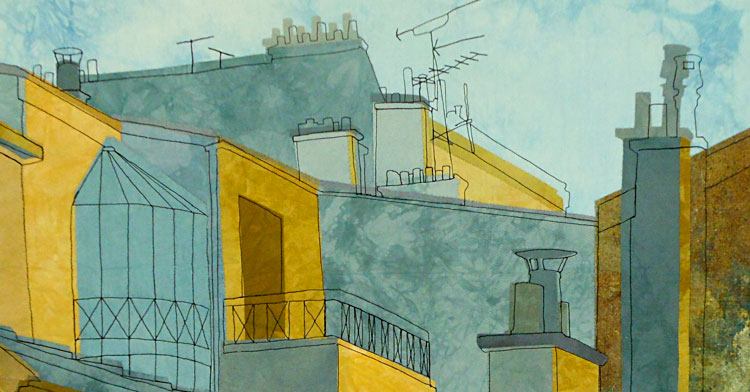
Canadian artist Heather Dubreuil creates contemporary art quilts inspired by the urban landscape, combining hand-dyed cotton shapes and machine stitched line work. She began working in cloth while studying an Honours degree in Fine Arts at Concordia University.
Heather is a Juried Artist Member of Studio Art Quilt Associates (SAQA), Text’art Fibre Artists, Hudson Artists Association, Women’s Art Society of Montreal and the 12 by the Dozen international blogging group.
In our in-depth interview with Heather, she tells us about the evolution of her work and offers some indispensable advice for aspiring artists.
An early interest in art
TextileArtist.org: What or who were your early influences and how has your life/upbringing influenced your work?
Heather Dubreuil: From my earliest years, I recognised that textile art could be a legacy. My mother died when she was barely thirty. She was a talented needlewoman, and the handknit sweaters, embroidered blouses, cross-stitch samplers and tailored suits she left behind told me a lot about who she was.
What was your route to becoming an artist?
When I was a gawky teenager, my mother’s brother brought me along for a day to his university classes, where he was studying fine arts. He continued to show his confidence in me by giving me art books for Christmas. In retrospect, this had a big impact. I earned a B.F.A., with a major in Art Education, and became an elementary school teacher who loved to teach art. I think the degree was an indicator of an early interest in art as much as it was a formative experience in itself.
Of course I have taken many workshops in dyeing, stitching and collage. And I seek out opportunities to look at art, whether at local galleries, in books, or through travel. I am so lucky to have a husband whose idea of a wonderful holiday is a week in a big city, devoted to visiting art museums and galleries. Teaching, reading, looking, travel, workshops, membership in art groups – life itself, or as Zorba said, “the whole catastrophe” – have all led me to where I am today.
Skeleton of line and shape
What is your chosen medium and what are your techniques?
My chosen medium is the art quilt. I begin with a photo, usually my own, and transform it into a drawing. I fuse pieces of hand-dyed cotton into place to indicate the major shapes, and then superimpose the drawing in thread onto the composition with a machine-stitched line.
How would you describe your work and where do you think it fits within the sphere of contemporary art?
Much of the contemporary art I see in galleries is conceptual, and though I find it interesting, I relate more closely to the concerns of ‘formalists’: colour, line, shape, texture, and composition.
At the same time, I am very much aware of the culture of women’s needlework and its history as a vehicle for self-expression. I see my work as a contemporary embodiment of this tradition.
Tell us a bit about your process and what environment you like to work in.
Mostly I work from my own photographs. One of my favourite moments is seeing the drawing emerge from the photograph, that skeleton of line and shape. Choosing the cloth in colours that “play well together” is another highlight for me. I like to have a broad selection of hues, tints and shades on hand before I begin a piece, but sometimes I do have to stop midway and dye something special. Once my two daughters left home, I knocked down the wall between their bedrooms and now I have a large, bright studio where I can muck about with dyes.
Urban landscapes
Do you use a sketchbook?
I used to feel apologetic about not using a sketchbook. But I attended a talk by Leni Levinson Weiner last year, a fiber artist whose work I admire very much. Leni is best known for her portrayal of the figure in the urban landscape. She has worked as a photographer in the past, and as she put it, “The composition, the perspective and the values are all there in my photos. Why would I need to use a sketchbook?” Sometimes it seems to me that a preoccupation with one’s sketchbook can take the place of actually making finished work.
What currently inspires you and which other artists do you admire and why?
I am inspired by the urban landscape, by the interlocking shapes of buildings, the rhythmic patterning of windows and doors, the strong diagonals built into street scenes, and the juxtaposition of old and new architecture.
I was delighted to hear my imagery compared to that of Edward Hopper. I love the way his buildings assume their own importance, not as background, but as major players on the stage of the canvas. Hopper often used an elevated point of view, or a worm’s eye view, offering a novel perspective on a street scene. Sometimes he cropped his subject radically, creating a more dynamic composition. He was just as likely to take as his subject the chimneys and ventilation shafts on the rooftop as the building itself.
I am very taken with the paintings of Wolf Kahn, an American painter who transforms the rural landscape by imposing his own palette on the barns and woodland scenes around his Vermont home. A masterful colourist, Kahn’s bold choices surprise and delight, all the while retaining a consistency within the confines of the canvas.
Matisse’s sumptuous use of colour inspires me too. He didn’t hesitate to flatten the space of his interiors, the better to create an energy between the shapes on the picture plane. His fascination with textiles is revealed in his lavish ornamentation and scintillating colour: how I would love to use pattern like that!
Unexpected use of colour
Tell us about a piece of work you have fond memories of and why?
’53rd Street West’ is one of my favourite pieces. I based it on a photo I took from a window in the Museum of Modern Art in New York. Considering the photo, I said to myself, “There is way too much detail here. How can I attempt that?” But I did, and what I still like about the piece is the bold and unexpected use of colour. Making this piece told me a lot about what was possible.
How has your work developed since you began and how do you see it evolving in the future?
Before I ever made an art quilt, I made lots of traditional quilts, at first with a “folk art” flavour, later more refined, using border prints or batiks. Workshops and Quilting Arts magazine guided me to a point where I was able to use sun prints, image transfer, machine- and hand-stitching, stamping and stencilling to make my first art quilts, my ‘Walk in the Woods’ series. These were essentially samplers on a grid, that featured little snippets of poetry.
My next series, ‘Seeds, Pods and Husks’, used many of the same techniques, but were liberated from the grid and blossomed into organic shapes.
‘Love, Love, Love’ employed transparencies, image transfer and embellishment to describe what I call “the Eternal Feminine”.
My Tuscan series was the first to use my own photos of architecture, transferred to cloth. Textures of brick and stone were introduced with stitching that was then painted, and here I was influenced by the painterly art quilts of Deidre Adams.
My current series of Cityscapes began about two years ago. My very first piece was based on a composite of photos taken in Quebec City. It’s basically a line drawing in stitch, with a little image transfer to add detail. I did several city scenes like this, with black machine stitching on a hand-dyed grey background.
I was fortunate to take some on-line classes with Elizabeth Barton, who encouraged me to add coloured shapes to my imagery. Elizabeth is a wonderful teacher and I would recommend her on-line classes and her books, ‘Inspired to Design‘ and ‘Working in a Series‘.
My current artist statement says, in part, “Heather’s cityscapes show the radiant transformation of an everyday exterior through the expressive potential of colour. She creates sensuous, aesthetic delight by a careful consideration of form and composition.”
Even after two years, I feel that my Cityscapes offer lots of scope and potential for growth. I continue to be fascinated with the urban landscape and plan to use it as a vehicle for colour play for some time to come.
What advice would you give to an aspiring textile artist?
Just Do It
One of the many bits of inspirational text pinned to my studio wall reads:
How we spend our days is, of course, how we spend our lives – Annie Dillard
Years ago, I was intrigued by ‘The Artist’s Way,’ by Julia Cameron. I diligently wrote in my journal for half an hour every day, picking apart all the obstacles that lay in my path to becoming an artist, all my inner conflicts and fears. After six months of this, I realised that if I were to simply put the same amount of time and effort into making art, I would be much further ahead.
Now perhaps it was the experience of journal writing that prepared the ground for this realisation. But my advice to aspiring textile artists is to just Do the Work. In this vein, I would recommend the books ‘Art and Fear‘ by David Bayles and Ted Orland; ‘Creativity for Life‘ by Eric Maisel; and ‘The War of Art‘, by Steven Pressfield.
Look at all kinds of art
Do not limit yourself to the world of textile art. Seek out opportunities to see good art and look at it critically. Why those colours? Why that placement? Where is the focal point and how is it established? How does the eye move around the composition? What creates the visual excitement? Would I want to return to this piece again and again?
Find your own voice
If you want to find a wider audience, you need to develop a ‘body of work’. That means not only a collection of a dozen or so good pieces, but also a consistency in the collection, something that will allow the viewer to recognise the work as distinctively yours, with your personal voice.
Be prepared to work at finding an audience
Regrettably, I spend more time on promoting my work than I do in the studio itself. Answering calls for entry, publicising shows, teaching and attending conferences: all of this takes time. Sometimes I will join a group because it offers opportunities for networking and for exhibitions. (It can also offer friendship, inspiration and mutual support.) Group membership takes time.
I don’t turn down many chances to show my work. I direct myself more towards art venues than quilt shows, but that is a personal choice. I have found that it is often small opportunities that lead to bigger ones. Currently, my work is on display at the neighbourhood medical centre, at an art lending service, and in group shows at two small rural galleries.
I resisted the idea of blogging for some time, thinking it would distract me from working in my studio. In fact, my commitment to posting regularly has helped to keep me disciplined, on track, and focused on my own art and the art around me. It has become my journal of what I am doing as an artist.
Upcoming shows
Do you give talks or run workshops or classes? If so, where can readers find information about these?
Years ago, I taught often, giving classes on colour theory and machine quilting. It seemed to be a natural consequence of having spent years as an elementary school teacher. You know the saying, “Once a teacher, always a teacher.” But as I recognised the need to develop my own work, I concentrated on studio time and finding exhibition venues. While I do not actively seek out teaching opportunities, I am open to the occasional invitation. I post my workshops and classes on my website.
Where can readers see your work this year?
My upcoming shows for 2014 include:
February 8 – 27
Kirkland Library, Kirkland, QC (solo)
April 11 – 13
Hudson Artists, Hudson Community Centre, Hudson, QC
May 1 – 15
Women’s Art Society of Montreal, Montreal, QC (juried)
June 11 – Aug 16
Arbor Gallery, Vankleek Hill ON (solo)
Sept 27 – Oct 21
Atrium Gallery, Ottawa ON (solo)
October 17 – 19
Hudson Artists, Hudson Community Centre, Hudson, QC
Oct 23 – Nov 16
‘Synthesis II’ (SAQA regional) Gibson Gallery, Amherstberg, ON (juried)
Details of these shows will be posted on my blog heatherdubreuil.blogspot.ca and on my website heatherdubreuil.com. As a Juried Artist Member, my work can also be seen on the SAQA website.
To find out more about Heather Dubreuil visit heatherdubreuil.com.
If you’ve enjoyed this interview, why not let us know by leaving a comment below?

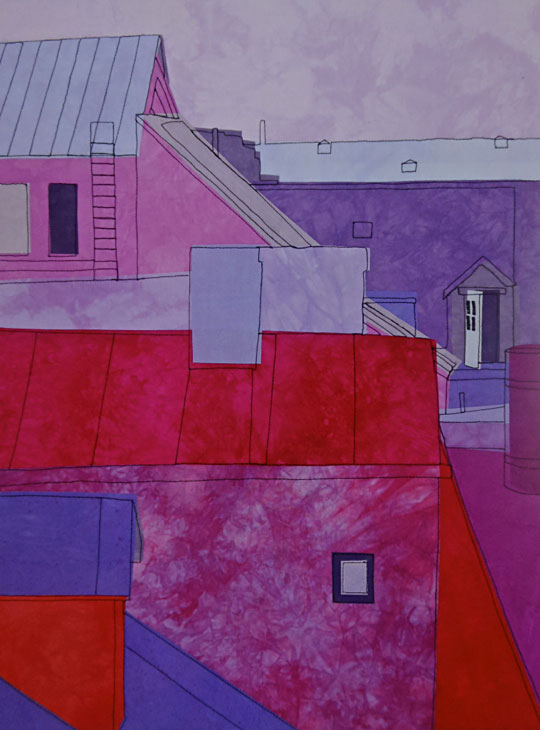
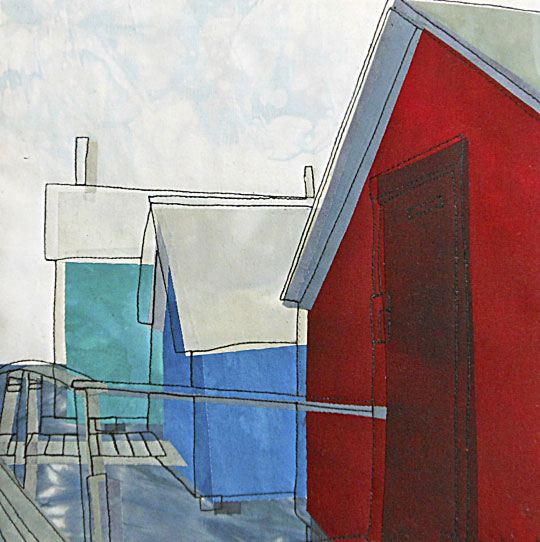
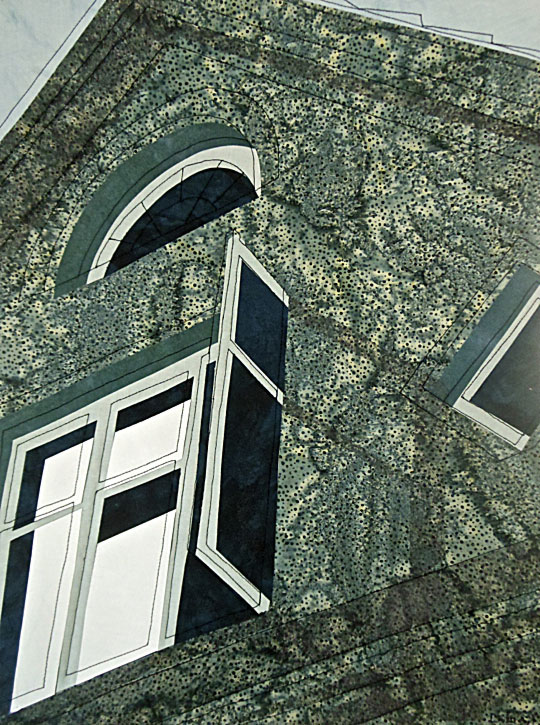
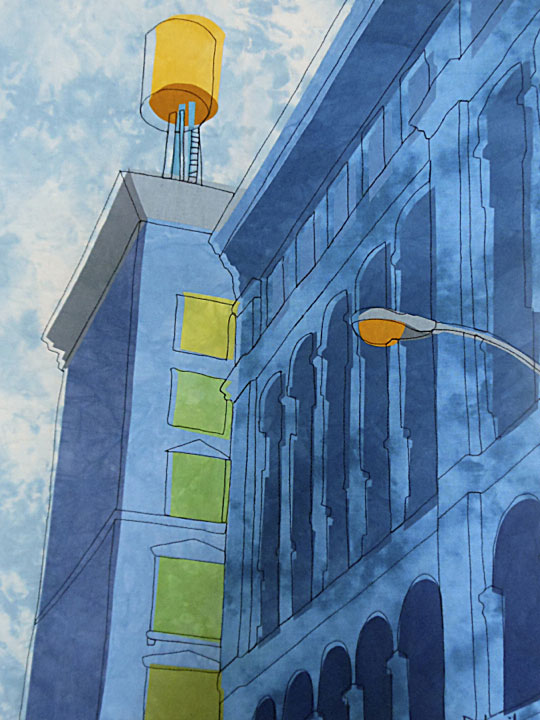
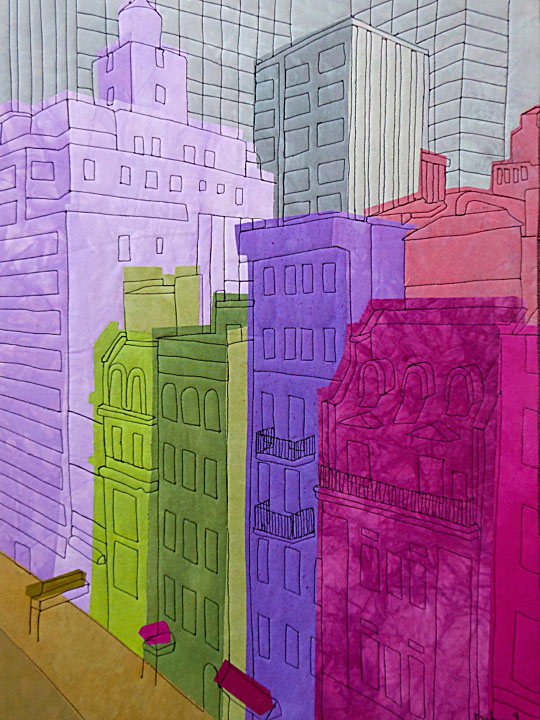
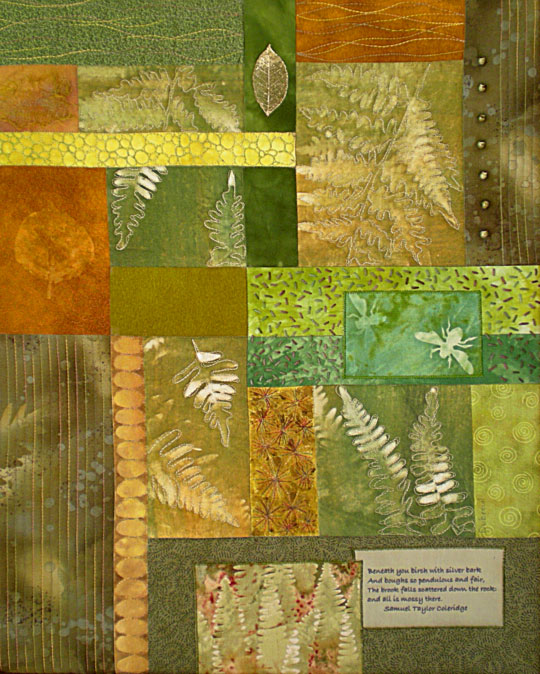
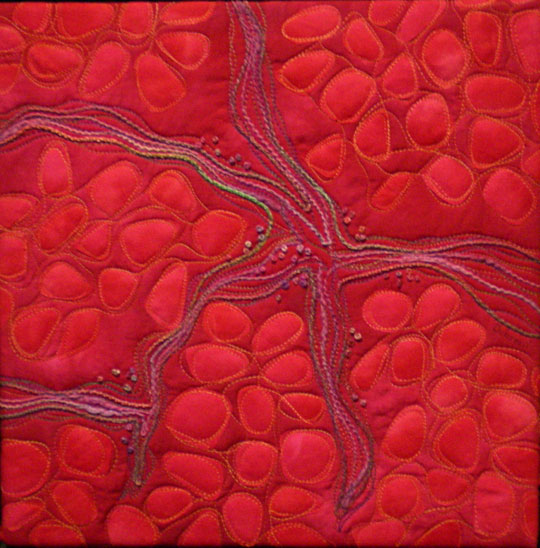
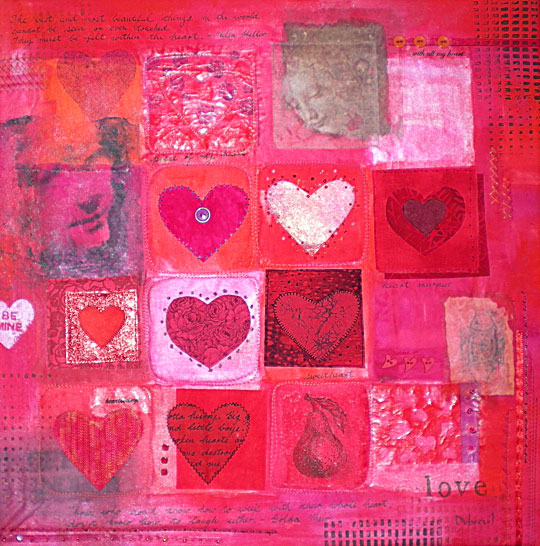
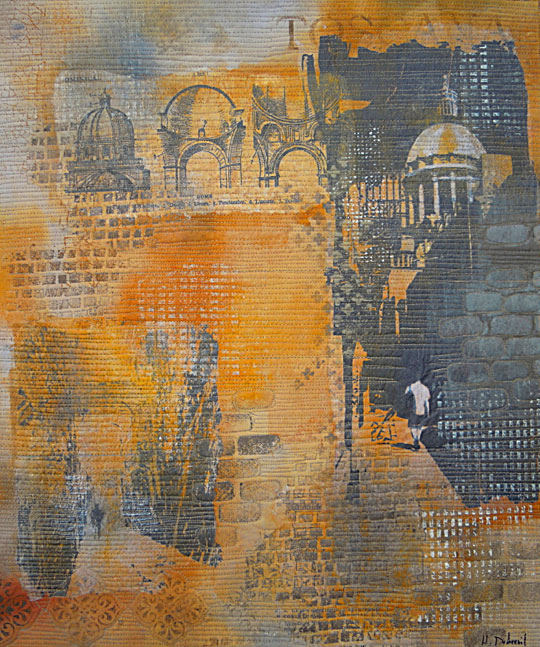
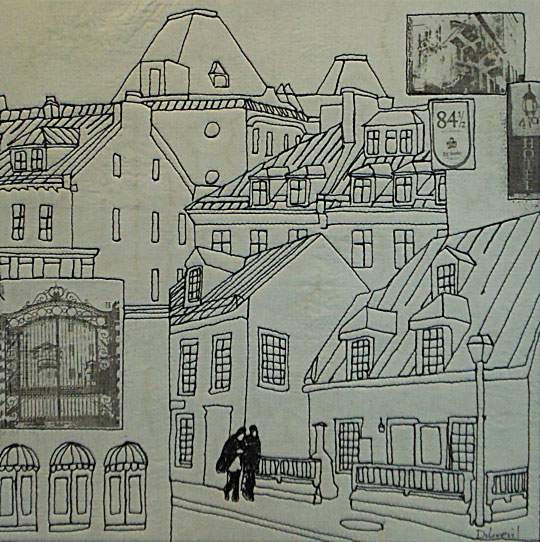
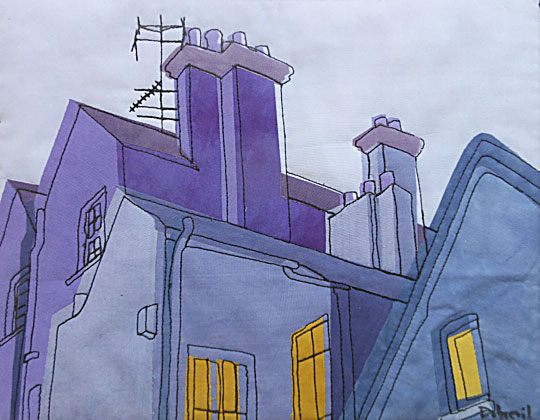
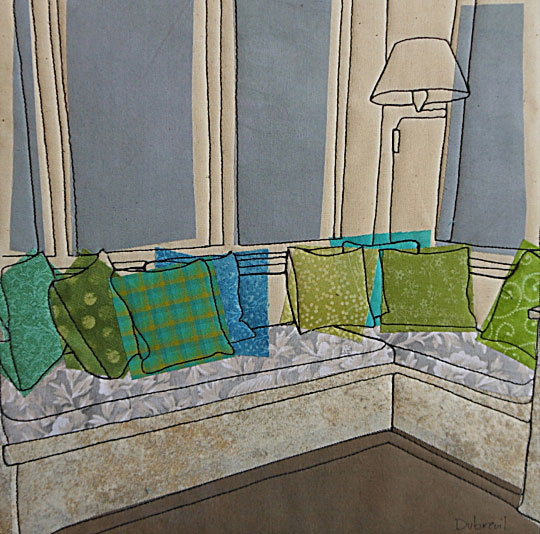
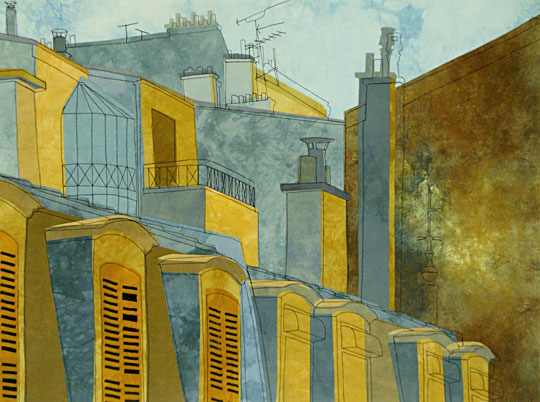















What a joy to see Heather’s development of her style. I love her cityscapes. It’ll be fun to watch her career explode.
This interview is intriguing and so well expressed. Heather is obviously a very accomplished and creative artist who loves what she does. I really enjoyed the insight into how she developed as an artist, right from an early age. I also appreciate her discussion of how much time and effort is needed to become established in addition to time needed to create her pieces.
Well done Heather.
Very unique stuff……cool.
I really enjoyed this article and appreciate Heather’s generosity in sharing her journey and giving tips on how to become an established quilt artist. Her work is beautiful in its simplicity and use of colour and perspective.
I had the pleasure of meeting Heather at the SAQA conference in Santa Fe in 2013; it’s delightful to read this interview, get to know her better through it, and to see her beautiful work. Thank you.
I find Heather’s textile art a visual treat for its unique view and personal expression. I appreciate seeing the evolution of her work and reading that she, too, deals with the challenge of how to find a balance between studio time and creating a public presence of one’s artwork. How lovely it would be to have an assistant who sits at the computer and fills out entry forms while we luxuriate in playing with fabric!
I love Heather’s work and am very inspired by how she portrays her work to make it look so simple yet extremely meaningful.
I am recently interested in textil art and find all the tips Heather gives in this article very useful. Thanks for sharing.